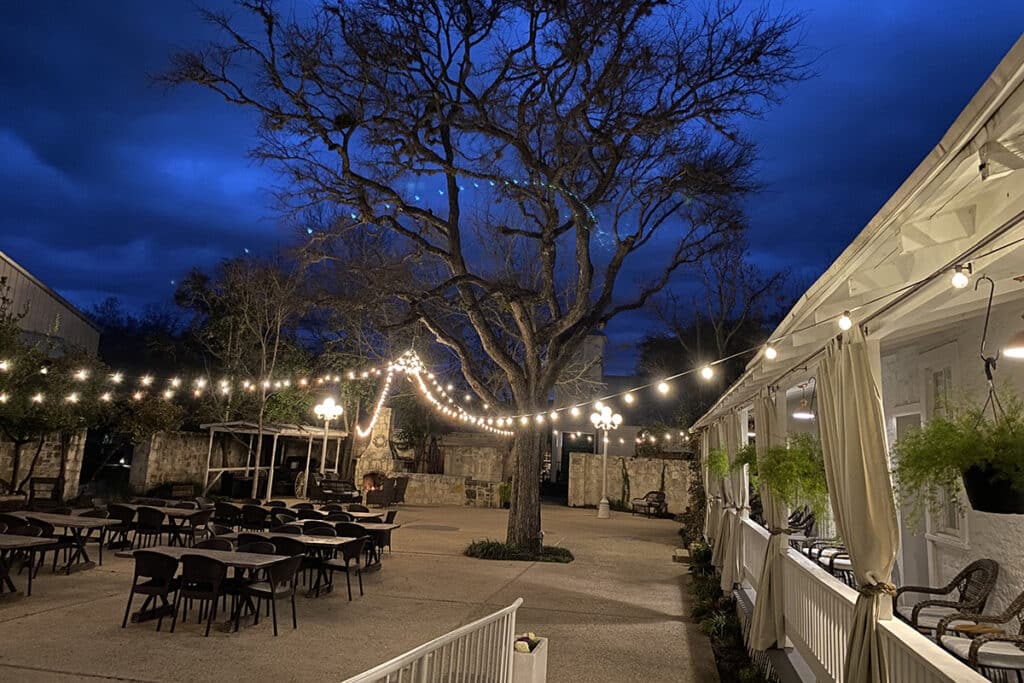In the costume shop of the University of the Incarnate Word’s theater department, Margaret Mitchell has laid out six or seven drawings of costume designs on a large counter. The pictures show women clad in lush, flowery long dresses with plunging necklines, while the men, at least the younger ones, appear sleek in black leather. In one drawing, an older gentleman looks like Henry VIII. All this attire was actually worn by actors in a recent production of Much Ado About Nothing produced by Austin Shakespeare in May. Amazingly, Mitchell, who has been in the theatrical design business for more than 20 years, had never worked on this play before. “The director told me that she wanted a sharp difference between the men and the women,” explains Mitchell, pointing to the drawings. “I decided not to go strictly Elizabethan but to abstract the Elizabethan period into a more modern look. That’s why the men display a kind of biker aesthetic in black leather, and women wear these feminine dresses that are reminiscent of the period but simplified.”
Mitchell went to New York to buy the fabrics, as the selection is becoming increasingly limited in both Austin and San Antonio. With fewer people sewing nowadays, fabric stores have been closing, she notes. Inspired by the colors and textures of her purchases, she started drawing on the plane ride back.
Costumes are, of course, only one aspect of a stage production, but they are a more essential part than most theatergoers realize. On the obvious level, they define the time and place in which the action is set, but even more importantly, they contribute to the actors’ interpretation of their roles. It is up to the costumer to teach the performers, especially student actors, how to inhabit their stage clothes with ease and how to adopt the proper body language that goes with the clothes. “It’s like alchemy,” says Mitchell. “Not only do you decide what actors will wear, but then there is the process of transformation during the fittings. You become part teacher, part psychologist, part salesman. With students, I have to teach them what to do with a train, for instance, or how to handle a hat, how to walk down the stairs. Professional actors come prepared, but they have their own demands. Every leading lady — and leading man — makes friends with the costume designer.” In mid-July, Mitchell’s attention was already turning to the UIW season, which will feature two plays this fall, the funny and poignant Real Women Have Curves by Josefina Lopez and the perennially beloved A Christmas Carol. While the costumes for the latter already exist, Mitchell had to start from scratch on Real Women, a play about a group of Mexican-American seamstresses working in a Los Angeles dress factory in the early 1980s. Period costumes may be more glamorous, but contemporary or nearcontemporary ones often present more of a challenge.
“It can be deceptively hard. I would rather do a period show,” Mitchell emphasizes. “With recent times, like the “80s, people often have different perceptions of what is accurate for that time and setting. Because of that, my choices have to be very specific. I do have to do research. Since the style here will be realism, I have to find out what women who worked in those sweatshops looked like. Period design is more fun; it allows for more imagination. I can live in my head in a particular historical period for a while.” She is especially fond of the late 18th century and the Elizabethan era. A theater professor at UIW for the last 18 years, Mitchell has designed both sets and costumes — and occasionally directed — more than 120 productions at the school as well as for venues in Austin, Dallas, Fort Worth and in Wellington, New Zealand. Her designs have been shown twice at the McNay Art Museum, first in an exhibit focusing on Broadway musicals and later in Shakespeare’s Haunted Stage in 2007. The latter featured 10 Mitchell drawings plus two actual costumes.
For her local work, she has received multiple Globe Awards from the Alamo Theater Arts Council (ATAC).
When I interviewed her last, some 10 years ago, Mitchell spoke of her desire to spread her wings internationally, and in the interim she has done so, to a certain degree. Among other things, her designs were included three times in the United States National Exhibition at the Prague Quadrennial, an international theatrical design competition-cum-conference where countries compete against one another. At 43, she has a long career still ahead of her, yet Mitchell is already garnering some major accolades. On Oct. 5, she will become the 18th recipient of the Jasmina Wellinghoff Award for Special Contribution to the Theater, to be presented at the annual Globe Awards Show and Gala at the Charline McCombs Empire Theatre. (Yes, the award bears the name of this columnist, who was the founder and first president of the Globes’ sponsoring organization.)* “It’s a big honor to be recognized by my colleagues in the community. But I was also a little surprised because sometimes I feel like people don’t know me because I am not in the thick of San Antonio theater,” says the designer, referring to the fact that she has not worked with other companies in town. But director and ATAC board member Diane Malone sees it a bit differently:
“Margaret is always willing to help other theaters if they need to borrow costumes or with advice or just to talk about costuming. All the nun costumes we used for Nunsense (at the former Church Theater) came from UIW. And she’s such an artist, a world-class designer who is right here; a true local treasure.”
So will the honoree design a special outfit for herself for the occasion?
Yes, she probably will, says Mitchell.
A DIFFERENT
PERSPECTIVE ON LIFE
Normally, she seldom bothers with her own clothes. Her work “uniform” consists of simple black garments in order not to interfere with the color palette of the show. Outside of work, she likes her clothes to be “fast and comfortable. I have little desire to make my own clothes,” she explains. “It’s like, if you work in the ice cream store, you really don’t want to eat ice cream. And even if I designed something for myself, I would have a dressmaker make it. The only thing I sew these days is my son’s Halloween costume.”
Lucky kid! Divorced from her first husband, Mitchell has been a single mom for the last two years, but that may soon change. She is currently in a serious relationship with another man whose name she prefers to keep private for the time being. When she speaks about her 6- year-old son, Zachary, however, there is no reticence. Then her manner gets so animated that it’s clear he has brought new joy into her life. Because he was adopted from Child Protective Services as a toddler, Mitchell has also become somewhat of a crusader for local adoptions through CPS. “He is fantastic,” says the enthusiastic mom. “Several friends followed suit and adopted from CPS, too, because of Zachary. Why go to China or Romania, or pay thousands of dollars to private agencies when many perfectly healthy kids need loving homes right here?” What’s more, she says, it costs nothing, and these children are promised a free college education paid by the state. A native San Antonian who grew up in Fort Worth, young Margaret was about 14 the first time she realized that doing stage scenery and costumes was actually someone’s job. She promptly set out to figure how to go about it. When time came for college, Mitchell enrolled in theater arts at Texas Wesleyan College, only to be told that there were no scholarships available for scenic design students. Thus, she became an acting major who “designed on the side.” Later on, however, she also earned an M.F.A. in costume design and technology from UT Austin. In her current position as one of four full-time faculty in UIW’s theater department, she teaches four different courses to 52 drama majors in addition to working on shows. Her students are her greatest contribution to the community, she notes.
Mitchell’s career might have developed differently had she not followed the advice of nationally known designer John Conklin, who reviewed her portfolio while she was still in graduate school. At the time, the novice designer was considering heading to New York to find work as a design assistant on Broadway. “He told me, “Don’t do it. If you start on that path, you’ll never stop assisting because the money is good,'” she recalls. “‘If you want to become an artist in your own right, start in a smaller venue and build up from there.’ That’s the best advice I ever got.” About 10 years ago, professor Mitchell was also instrumental in establishing an ongoing artistic exchange of faculty and students between UIW and the National Drama School of New Zealand, called Toi Whakaari O Aotearoa in the Maori language. The New Zealanders have visited San Antonio to teach and co-stage various productions, and she has traveled several times to their country to do the same. As if all of that, plus her summer jobs, weren’t enough, the designer has been working on a major history of design book with collaborators Oscar Brockett from UT Austin and Linda Hardberger, the former curator of the Tobin Collection of Theater Arts at the McNay.
“Robert Tobin wanted this book to be written,” explains Mitchell, “and the Tobin Foundation is paying for the work. Part of his amazing collection is featured in the book. For us, it has been a huge, 10-year undertaking. Oscar is handling the history part, while I am writing the technical part. Linda is preparing separate sidebars describing the public’s attitude toward theater through history.”
Fortunately, the book is almost finished. Since becoming a mother, Mitchell has stopped doing scenery and has tried to cut down on other engagements to focus more on her son and some nontheater related goals, such as returning to her love of painting and learning to play the piano.
“Having a child gives you a different perspective on life. It used to be all about work and career; now it’s no longer all about that,” she says. “I want to spend time with Zachary. And I have a lot of soccer and basketball games in my future!”
*This columnist is no longer involved with ATAC and has in no way participated in the selection of the award recipient.
For more information about the 18th Globe Awards Show and Gala, go to www.atac-sa.org.
Author: Jasmina Wellinghoff
Photographer: Janet Rogers




